Collaboration and innovation are key to ending TB: WHO China Office and GHDDI hold joint symposium in Beijing
[March 13, 2024; Beijing, China]
Ahead of World Tuberculosis Day, the World Health Organization (WHO) China Office and the Global Health Drug Discovery Institute (GHDDI) convened a symposium in Beijing on March 13, 2024, dedicated to ending tuberculosis (TB).
The symposium put the spotlight on the critical challenges and opportunities in China’s fight against TB, underscoring the urgency of forging collaborations, harnessing innovation, and increasing accessibility to translate commitments into actionable solutions.
The Global Tuberculosis Report 2023 issued by WHO shows that in 2022, TB was the second leading cause of death from a single infectious agent worldwide. In 2022, 1.3 million people died from TB globally, second only to deaths resulting from COVID-19 infection, with TB causing almost twice as many deaths as AIDS. An estimated 10.6 million people fell ill with TB worldwide in 2022, similar to 2021. China continued to have the third-highest number of TB cases, with 748,000 people developing TB in 2022, accounting for 7.1% of all global TB infections in 2022. In China, the treatment success rate for MDR/RR-TB was only 51%, lower than the global average (63%). Although TB is preventable and mostly curable, it remains a major global health challenge today.
At the High-Level Meeting on the Fight Against Tuberculosis at the 78th Session of the UN General Assembly in September 2023, Wang Hesheng, Vice Minister of China's National Health Commission and Director of the National Disease Control and Prevention Administration, reiterated China’s commitment to ending TB. “China stands ready to continue to support the work of the United Nations and join hands with other countries to strengthen exchanges and collaboration and participate more actively and fully in global public health governance, so as to contribute to improving the health and well-being of the millions of people affected by TB and to building a global community of health for all.”
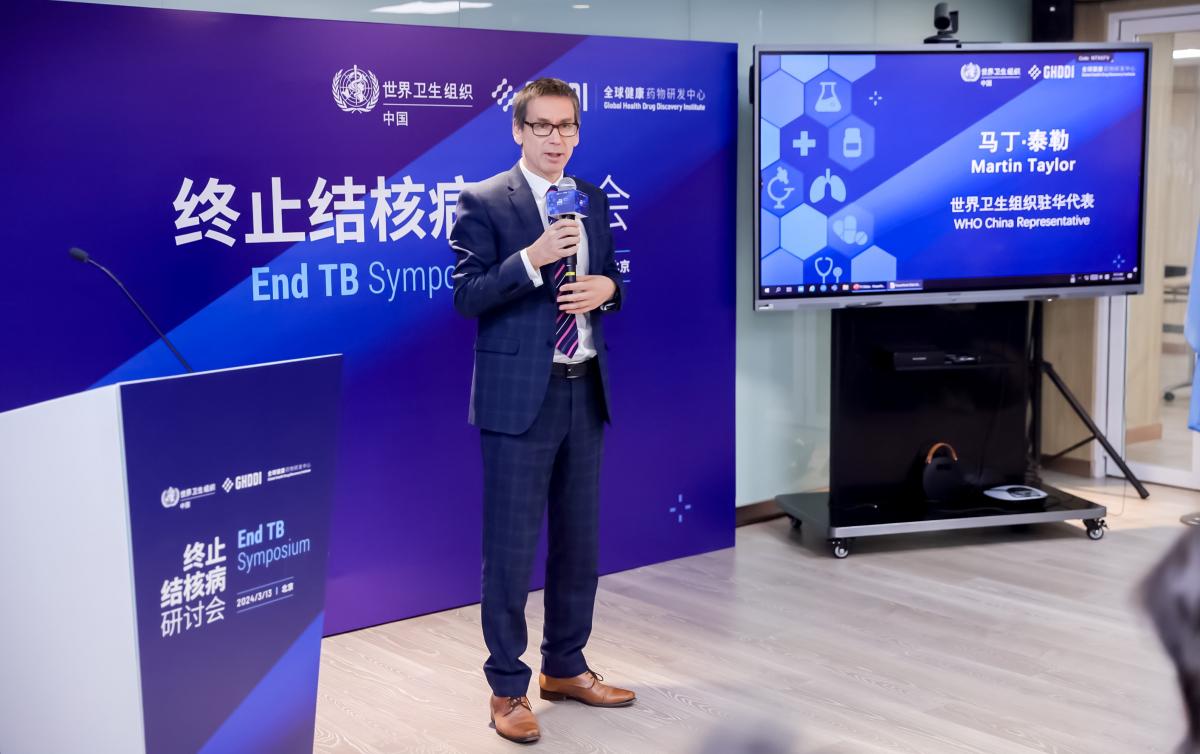
▲Keynote speech by Martin Taylor, WHO China Representative
“China holds a pivotal role in ending TB”, said at the symposium by Martin Taylor, WHO China Representative. “Ending TB is not just about improving people's health. It’s also about a reduction in days of work lost and unemployment due to illness; it's a contribution to productivity, economic growth, and reducing poverty or the risk of people falling into poverty.” He added, “It’s time to turn commitments into tangible actions. With the right investments and actions in advancing TB care and research and reducing catastrophic costs, China can accelerate progress towards ending TB. This is especially critical to close gaps in care and to ensure equitable access to prevention and care in line with WHO’s drive towards achieving Universal Health Coverage. Supporting the scale-up of new TB prevention, detection, and treatment programs recommended by WHO will help improve health outcomes and save millions of lives.”
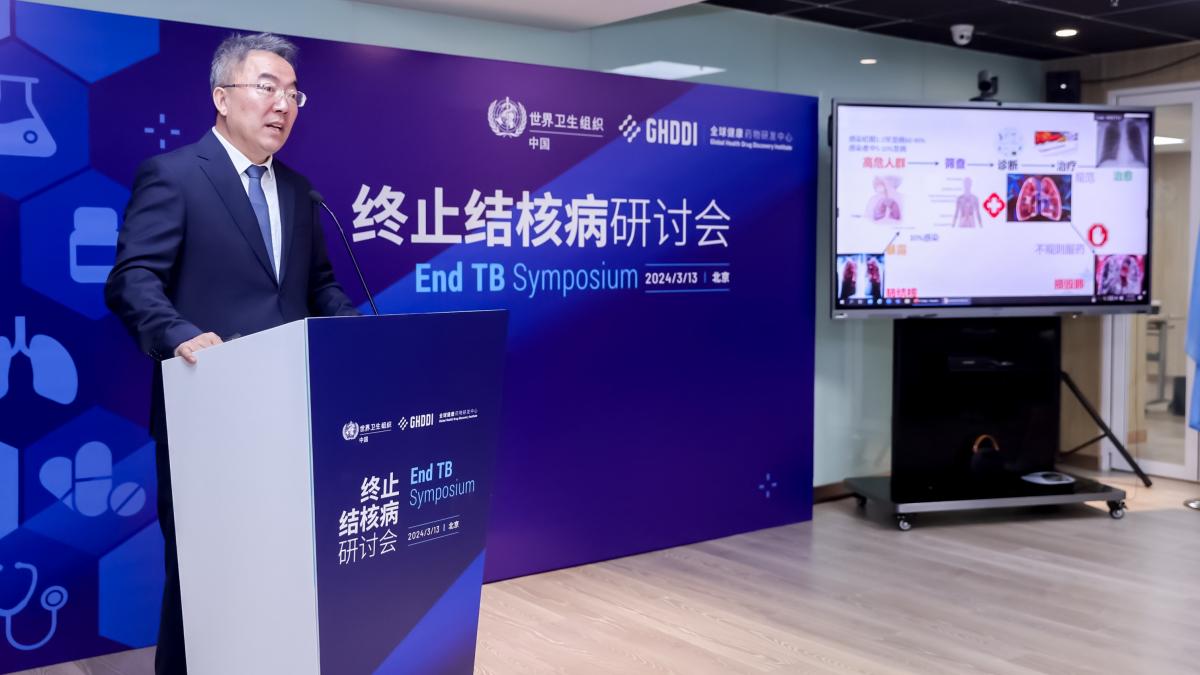
▲Keynote speech by Zhao Yanlin, Director of the Center for Tuberculosis Control and Prevention of China CDC
Zhao Yanlin, Director of the Center for Tuberculosis Control and Prevention at the China CDC, highlighted China’s progress in TB control while acknowledging challenges have to be overcome. “TB is a major infectious disease that China is focused on controlling, and to achieve the goals of reducing the incidence of TB by 80% in 2030 and by 90% before 2035, based on figures in 2015, and ending catastrophic household expenditure, it is necessary to strengthen the TB prevention and treatment service system, improve the technical strategy, use innovative tools, and implement an integrated prevention and treatment model.” Zhao emphasized that China needs “to focus not only on pulmonary TB, but also on extrapulmonary TB, stopping human-animal transmission, and introducing new tools for proactive detection and preventive treatment. Innovation is key to addressing challenges such as drug-resistant TB and improving access to TB treatment.”

▲Keynote speech by Zhang Wenhong, Director of the National Medical Center for Infectious Diseases
The symposium also shed light on the urgent need for innovative approaches to TB prevention and control from a clinical perspective. Zhang Wenhong, Director of the National Medical Center for Infectious Diseases, emphasized the importance of shortening the clinical treatment cycle for TB. “Our team has conducted several studies on short-course treatment regimens for TB, where the two-year treatment cycle for multidrug-resistant TB can be shortened to six to nine months, and the treatment cycle for generalized TB can be shortened to four months. Through drug metabolism and kinetics studies, we aim to accelerate progress toward ending TB with a modernized, integrated model, as well as a localized regimen that is more accessible and better suited to the drug metabolism of the Chinese population, which will improve patient compliance.” Zhang Wenhong emphasized, “It is technically possible to end TB, but we face difficulties at various levels, and there is an urgent need for synergistic collaboration among stakeholders.”
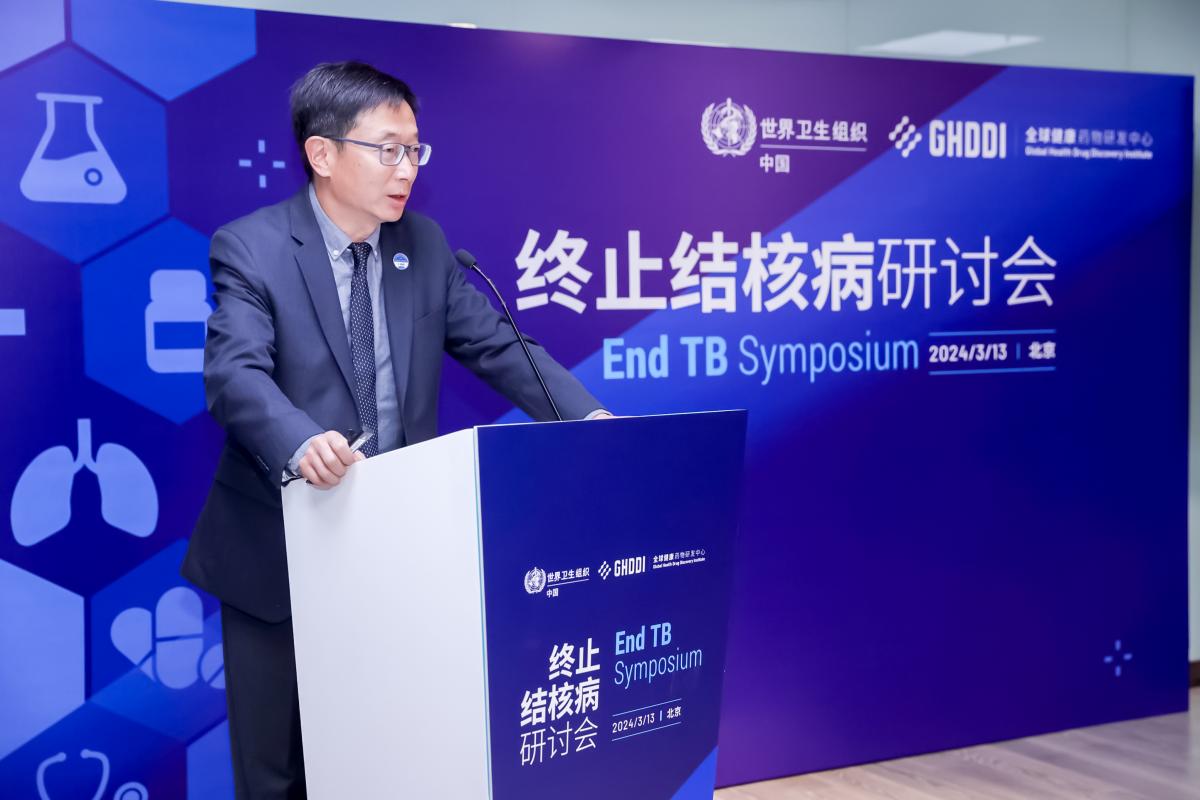
▲Keynote speech by Ding Sheng, Institute Director of GHDDI
Ding Sheng, Institute Director at GHDDI, stressed the importance of collaboration and innovation in order to overcome the challenges of TB drug discovery. “Mycobacterium tuberculosis has unique biological and structural characteristics that make drug discovery difficult and prolong development cycles. Multiple reasons have led to the emergence of drug-resistant TB, and rapidly changing TB bacteria have also developed resistance to some new drugs, making it crucial to accelerate the development of innovative anti-tuberculosis drugs through collaboration,” said Ding. “New drugs need several improvements, such as making them easy for patients to take to increase patient compliance, with low toxicity and side effects but high effectiveness. Through in-depth collaboration with top domestic and international organizations and disease alliances, GHDDI is advancing three TB drug development pipelines. One of them, GDI-2, a small molecule inhibitor, has made rapid progress and has the potential to significantly shorten the course of TB treatment from the standard four to six months to one to two months and provide new solutions for drug-resistant TB, and it is expected to become a preclinical drug candidate by the end of 2024.”
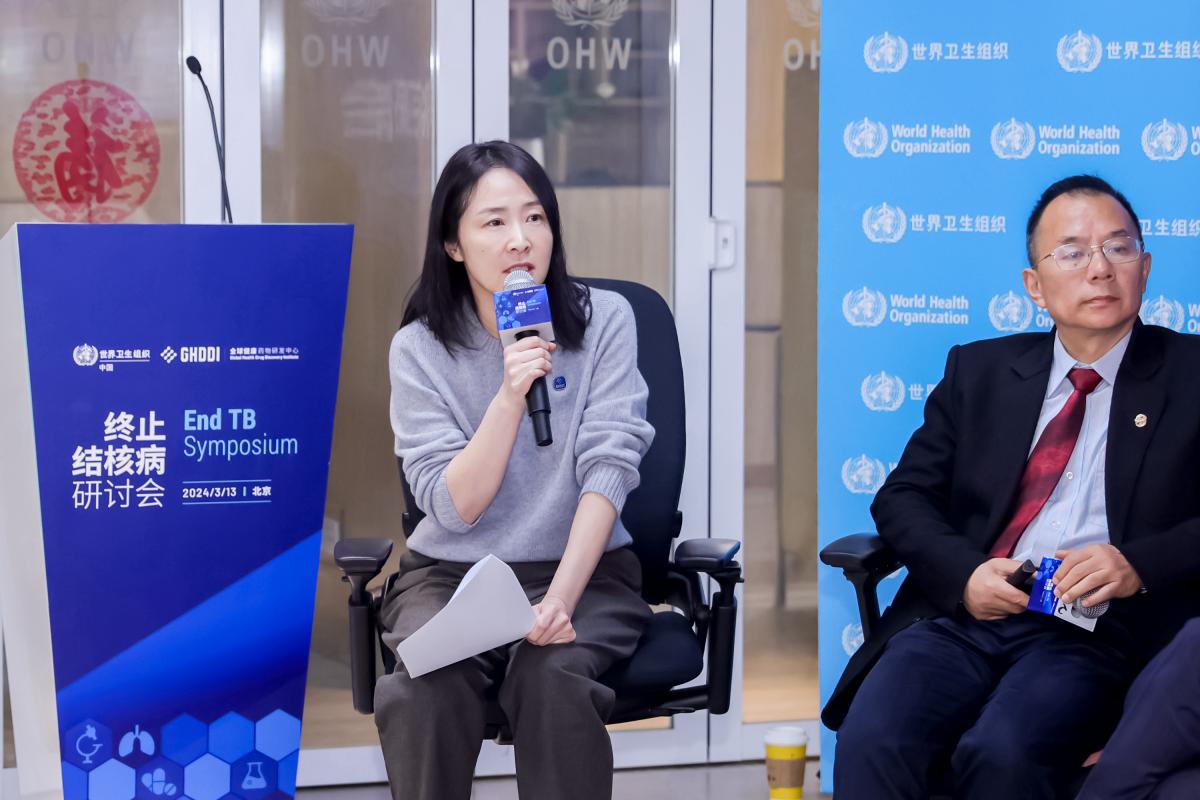
▲Panel discussion Moderated by Lu Manchun, Chief Operating Officer of GHDDI
The symposium featured a panel discussion moderated by Lu Manchun, COO of GHDDI, which provided expert insights on how collaboration can amplify innovation in the fight against TB. The panelists were Chen Zhongdan, Technical Officer at WHO China Office; Zhao Yanlin, Director of the Center for Tuberculosis Control and Prevention, China CDC; Ding Sheng, Institute Director at GHDDI; Zhang Wenhong, Director of the National Medical Center for Infectious Diseases; Huan Shitong, Senior Program Officer at the Bill & Melinda Gates Foundation; Zhu Limei, Director of the Institute of Chronic Infectious Disease Prevention and Control, Jiangsu CDC, and Zhao Jinzhao, a health journalist from Caixin.
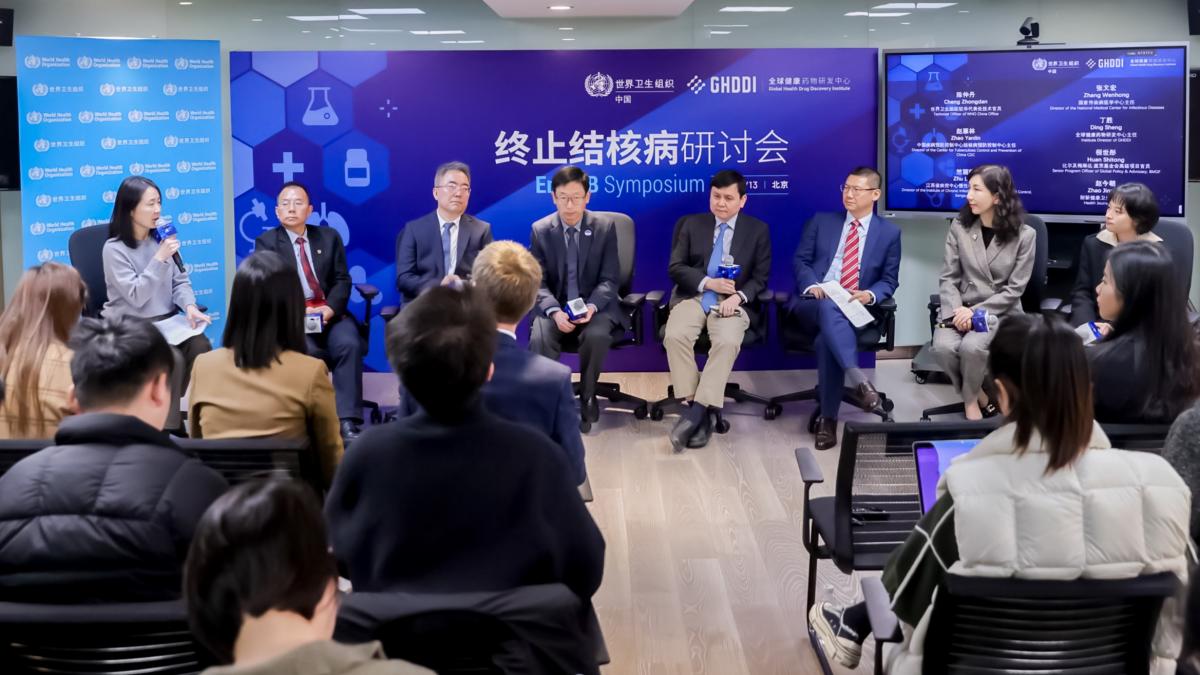
▲Panel discussion Moderated by Lu Manchun, Chief Operating Officer of GHDDI
Zhao Jinzhao shared insights from her frontline interviews, “Drug-resistant TB patients are very likely to drop out of treatment due to financial pressure or adverse drug reactions, and their compliance is low. Catastrophic expenditure for their families due to the disease, especially in rural areas, also creates a chain of economic and public health problems that need to be addressed at the societal level.”
In response, Chen Zhongdan offered a solution. “The key to the problem is to avoid catastrophic expenditure, where TB patients and their families spend more than 20% of their income on TB treatment. According to statistics, more than 50% of TB patients globally are affected by catastrophic expenditure. The proportion is even higher for drug-resistant TB patients, including in China. Unaffordable medical expenditure can lead to negative consequences for patients and their families, such as refusal to seek treatment after diagnosis, discontinuation of medication, and failure to take medication as prescribed. Many innovative drugs and treatment options are available to effectively treat drug-resistant TB, but they are expensive and unaffordable, even after reimbursement by health insurance coverage. Therefore, adequate funding, innovative financing and payment mechanisms, and better social protection are also necessary solutions for this group of patients.”
In addition, screening is an important tool in the fight against TB, Huan Shitong said, “There are also innovative TB screening tools that can be employed. For example, tongue swab sampling can play a very important role in early detection and diagnosis compared to the previous model of using sputum samples for testing. There is a lot of potential for R&D work of Chinese companies in this area. With more accessible and convenient testing tools for screening and proactive detection of TB patients, we will improve the efficiency of testing and early detection of the TB-infected population.”
Zhu Limei shared the experience of Jiangsu Province. “In 2023, the incidence rate of TB in Jiangsu Province was 22.8/100,000, which is among the provinces with the lowest incidence rate of TB in China. The treatment success rate of multidrug-resistant TB reached 85.6%, which is the highest in China. These results cannot be achieved without the Jiangsu Provincial Government’s flexible and coordinated use of funds and its year-on-year increase in investment in TB prevention and treatment, which has enabled Jiangsu Province to provide free TB screening, diagnosis, treatment and management. Jiangsu Province has pioneered the free treatment of multidrug-resistant TB, covering all second-line TB drugs in Group A and B, including bedaquiline. In addition, appropriate subsidies are provided to patients to effectively prevent catastrophic expenditure. The guarantee of funding also promotes the introduction and dissemination of new tools and methods that will further support TB prevention and treatment at the provincial level.”
March 24 is World TB Day. The theme of this year’s World TB Day is the same as that of 2023: “Yes! We can end TB!”. It conveys a message of hope that with high-level leadership, increased investments, and scale-up of new technologies and WHO-recommended treatment regimens, it is possible to get back on track and turn the tide against the TB epidemic. The active participation of WHO, government agencies, research institutions, hospitals, health workers, communities, and the public is essential to harness the potential of innovation in the collective effort to end TB.
About WHO
The World Health Organization (WHO) was established on 7 April 1948 as the directing and coordinating authority in global public health within the United Nations system. Working at three levels in the Organization (global, regional and country), more than 7,000 WHO staff worldwide collaborate with the governments of 194 Member States and other partners to achieve the WHO founding vision of the attainment of the highest possible level of health by all people.The WHO China Representative Office is the official representation of the World Health Organization in China, working with the People's Republic of China in achieving good health for China's citizens.
About GHDDI
The Global Health Drug Discovery Institute (GHDDI) was jointly founded by the Bill & Melinda Gates Foundation, Tsinghua University and Beijing Municipal Government in 2016 through an innovative Public-Private Partnership (PPP). It is an independent and not-for-profit research organization, first-of-its-kind in China. GHDDI is committed to improving global health and saving lives through the accelerated development of new drugs and innovative technologies.
GHDDI focuses on translational research – from the bench to the bedside. Its research areas include COVID-19 and antivirals, tuberculosis and malaria etc.
For more information, please visit www.ghddi.org.


